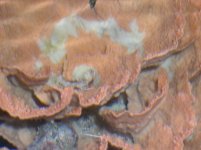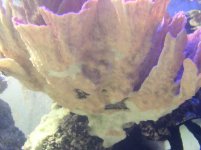My 2 1/2 year old son turned on my dosing pump last night before coming up stairs for bed. When I came down my tank was a white wonder land. I couldnt see 1" in the tank. My dosing pump liter meter was set to dose continously and didnt have the float switch on it. It runs through a kalkreactor which happen to be stirring during the time. SO in short my 75 gallon tank got ruffly a 5 gallon super kalk dose. I did an immediate 15 gallon water change, caught 3 of my 4 fish that were swimming around side ways and crashing in the glass. The wrasse I could find,and died. The other three I put n one of my other tanks untill today, they are fine.
I then lit a white tea candle put it in a large bowl, suspended a large airpump above it and pumped the air to the return pump in my sump causing it to blow tons of tiny bubbles to the tank. The idea was the CO2 from the candle would help increase the CO2 in the bowl where the pump was pulling the air from. The CO2 enriched air would help reduce the PH of the water. I figured if some toxins from the candle were released I was already screwed anyway so what the hell.
Do you think I responded to the situation the best I could????
All my SPS are generally fine today considering. The Acropora next to this Monti let out TONS and TONS of slime but seems to be ok today just stressed looking. My wife said in the morning this monti had a ball of slime in it. Now its starting to shed tissue. Is there anything I can do or am I going to lose it? I hope not beacuse I grew this over the last few years from a 1" square, it came from RichK who got it from SanJay Joshi who got it from Steve Tyree so losing it would be a real shame to me.
Hoefully some ones got some good advice. Heres the pictures.
I then lit a white tea candle put it in a large bowl, suspended a large airpump above it and pumped the air to the return pump in my sump causing it to blow tons of tiny bubbles to the tank. The idea was the CO2 from the candle would help increase the CO2 in the bowl where the pump was pulling the air from. The CO2 enriched air would help reduce the PH of the water. I figured if some toxins from the candle were released I was already screwed anyway so what the hell.
Do you think I responded to the situation the best I could????
All my SPS are generally fine today considering. The Acropora next to this Monti let out TONS and TONS of slime but seems to be ok today just stressed looking. My wife said in the morning this monti had a ball of slime in it. Now its starting to shed tissue. Is there anything I can do or am I going to lose it? I hope not beacuse I grew this over the last few years from a 1" square, it came from RichK who got it from SanJay Joshi who got it from Steve Tyree so losing it would be a real shame to me.
Hoefully some ones got some good advice. Heres the pictures.







